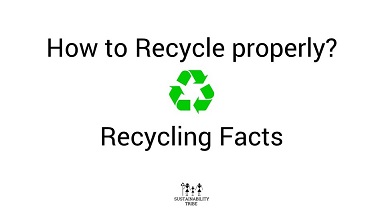
Let’s first look at the facts of recycling different materials.
Aluminum
Recycled aluminum saves 95 percent energy compared to virgin aluminum; recycling one can save enough energy to run a TV for three hours.
– Recycled aluminum reduces pollution by 95 percent.
– Four pounds of bauxite are saved for every pound of aluminum recycled.
– Enough aluminum is thrown away to rebuild our commercial air fleet four times every year.
Glass
– Recycled glass saves 50 percent energy versus virgin glass.
– Recycling one glass container saves enough energy to light a 100-watt bulb for four hours.
– Recycled glass generates 20 percent less air pollution and 50 percent less water pollution.
– One ton of glass made from 50 percent recycled materials saves 250 pounds of mining waste.
– Glass can be reused an infinite number of times; over 41 billion glass containers are made each year.
Paper
– Recycled paper saves 60 percent energy versus virgin paper.
– The recycled paper generates 95 percent less air pollution: each ton saves 60 pounds of air pollution.
– Recycling one ton of paper saves 17 trees and 7,000 gallons of water.
– Every year, enough paper is thrown away to make a 12-foot wall from New York to California.
– Production of recycled paper uses 80 percent less water, 65 percent less energy, and produces 95 percent less air pollution than virgin paper production.
– If offices throughout the country increased the rate of two-sided photocopying from the 1991 figure of 20 percent to 60 percent, they could save the equivalent of about 15 million trees.
Plastics
– Plastic milk containers are now only half the weight they were in 1960.
– If we recycled every plastic bottle we used, we would keep two billion tons of plastic out of landfills.
– According to the U.S. EPA, recycling a pound of PET saves approximately 12,000 BTUs.
– Not all plastics are recyclable. Only PET, HDPE, and PVC plastic products are recycled, and PS, PP, and typically LDPE are not recycled. Read a more in-depth article about plastic recycling here on balance.
Recycling Techniques
Once you have reduced your waste and made a plan, it is important to decide the disposal method you will use and the right steps for waste disposal.
You can also watch our Video Tutorial about ‘How to Set Up Composting & Recycling Station at Home.’
End of this article, you will also find a link to download our free e-book on the ‘Recycling & Composting Checklist,’ where you will find a setup and operations checklist.
Step 1: Separate the waste depending on the material. 
Examples:
– The paper recycling bin will contain white paper, colored paper, cardboard, office mail, magazines/catalogs, etc.
– The plastic recycling bin will contain each type of plastic: #1-7
– The metal recycling bin will contain all metals, tins, etc.
Though it is better to separate these waste like bins for plastic #1-7 or separate bins for aluminum and steel, this will add more prices to the waste and reduce time at the final stage of actual recycling. However, it might create space problems and increase the time to classify the waste and then throw it in separate bins.
It is easy to make different bins in a company because you can allocate space as a garbage area. Alternatively, you can locate different bins and inform your employees about the locations. If you are making different bi in an office, different materials, then you need to make it compulsory for employees to separate garbage. For papers, you can keep shredders and make sure all employees throw waste papers in a shredder at the end of the day.
We can make space for garbage bins in the balcony, terrace, bathrooms, hallway, or even space under the kitchen sink at home. The paper collection is not very dirty, so we can collect paper and then recycle it for a month. The waste from the kitchen or waste from vegetables, food, etc., we can go for compost in our personal garden or building garden for all. We get a low-cost compost bin in the market, or even we can make our own compost. If you live in an apartment, you can request the building management to allocate the garbage area where different bins for metal, glass, and plastic can be kept and recycled once a week. Building management can request the local authority to place a recycler in a nearby location.
Step 2: Find the recycler in the surroundings.
Here the local authority comes into the picture. In some countries like the US, Japan, UK, Canada, UAE, there are recyclers placed by the government in public areas. Interestingly, these countries have a carbon footprint on a quite higher level than the required.
In an overpopulated country like India, there were no recycling stations in public areas until a few years back. Only in some metro cities can you find recyclers. However, there has been an excellent system for many years. People collect the papers, metals, glass, plastic, clothes, electrical appliances, electronics, or even furniture broken or in good condition and sell it to people called kabadiwala/ bhangarwala once a month. These kabadi people act like a recycler. They collect these items and sell them to plastic, metal, glass, paper, furniture-manufacturing companies as raw materials. Therefore, collecting your waste can save energy and even earn money if you collect your waste. Many people even do compost in their gardens or fields. So people are keen not to waste things. Maybe this is a major reason why the carbon footprint in India is less than what is required.
If the government keeps no recyclers, find out some organizations, which recycle the products. Sometimes some shops have recycling junctions like some electronics shops accept mobiles, electronic waste. Electrical appliances shops accept electrical waste, acid batteries. Motor garage accepts tires, automobiles waste.
If there are things at your home, you want to get rid of it like books, clothes, spectacles, etc., instead of recycling them, you can give them away to needy people or to some charity organizations, which help the people in war or flood or earthquake.
For UAE, you can read the complete guide to recycling locations across the UAE.
Step 3: Improve the recycling process.
To reduce contamination and improve recycling efficiency, wash and squash!

· Scrape out any food remains/pour away excess liquid.
· Rinse the container (use your washing-up water)
· Don’t put recyclate in the dishwasher – no need to waste resources to achieve an unnecessary level of cleanliness!
Squash· Crush metal cans.
· Squeeze plastic bottles flat to expel as much air as possible.
These steps help prevent contamination and reduce the volume of recyclate, making collections more energy efficient.
Removing the caps and lids from plastic containers is more important. Plastic caps are often made from a different polymer type, and therefore have a different melting point compared to the plastic used for the bottle itself.
Step 4: Analyze your waste.
Consider conducting a waste audit to understand better the kind of materials entering and leaving your home, office, or school. Set a span of time, like a week or a month, and separate your waste categories. Weigh the different kinds of material flows that go out the door (landfill waste, organic compost, aluminum, recyclable plastic, reusable material, etc.). Then, design a “material recovery” program that minimizes the amount going to the landfill. This is a great exercise to do with kids to understand waste management and its importance.
To know more about waste management, please visit the following sites
http://www.recyclenow.com/
http://www.recycling-guide.org.uk/
http://kids.niehs.nih.gov/recycle.htm
Now that you already know the proper recycling techniques, why not give a thought to Zero Waste Lifestyle, where you can focus on reducing waste altogether. Of course, you still need to recycle, but far lesser than your regular day.
I have been following a zero-waste lifestyle in UAE for more than two years now, and believe me, it gives me more peace of mind and a healthier lifestyle, as I have reduced so much toxicity from home through this lifestyle.
Here, you can read our Beginner’s Guide to Zero-waste lifestyle, which many of our readers found very helpful and practical.
Happy recycling!
You can also access our self-paced online course, Sustainable Home Masterclass. This training is designed to give attendees a complete guide to sustainable homes, from selecting a property to what changes you can make in your existing property, including budget-friendly options. This course will also introduce green buildings and sustainable material choices. Plus, develop conscious consumption choices to select sustainable household items and develop simple habits for a healthy home. After this course, you will be able to gain enough knowledge to reduce your utility bills and cost elsewhere, improve your family’s wellness as well as contribute to climate action right from your home.

Amruta Kshemkalyani, an expert sustainability professional turned social entrepreneur, is the founder of the Sustainability Tribe, AK Sustainability
Read More >>
Copyright 2024 © Sustainability Tribe, Registered under 'Sustainability Tribe Marketing Management' in the U.A.E., Design by LBM INFOTECH
Thank you Shela, I am glad it was useful for you, please go ahead and share it in your circle! Let's make better future together!
Very useful information shared in the post.
Nice Post.